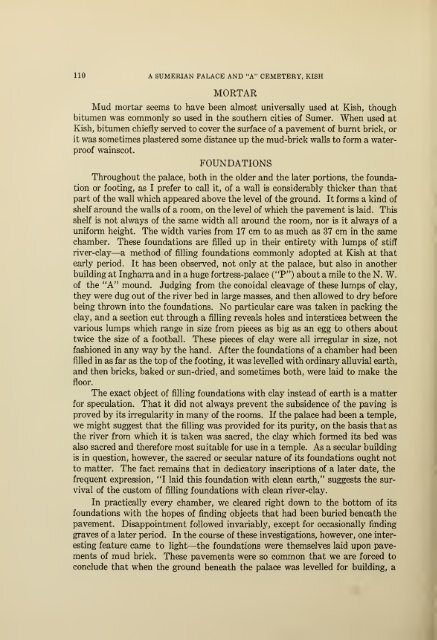A Sumerian Palace and the "A" cemetery at Kish, Mesopotamia
A Sumerian Palace and the "A" cemetery at Kish, Mesopotamia
A Sumerian Palace and the "A" cemetery at Kish, Mesopotamia
You also want an ePaper? Increase the reach of your titles
YUMPU automatically turns print PDFs into web optimized ePapers that Google loves.
110 A SUMERIAN PALACE AND "A" CEMETERY, KISH<br />
MORTAR<br />
Mud mortar seems to have been almost universally used <strong>at</strong> <strong>Kish</strong>, though<br />
bitumen was commonly so used in <strong>the</strong> sou<strong>the</strong>rn cities of Sumer. When used <strong>at</strong><br />
<strong>Kish</strong>, bitumen chiefly served to cover <strong>the</strong> surface of a pavement of burnt brick, or<br />
it was sometimes plastered some distance up <strong>the</strong> mud-brick walls to form a w<strong>at</strong>er-<br />
proof wainscot.<br />
FOUNDATIONS<br />
Throughout <strong>the</strong> palace, both in <strong>the</strong> older <strong>and</strong> <strong>the</strong> l<strong>at</strong>er portions, <strong>the</strong> founda-<br />
tion or footing, as I prefer to call it, of a wall is considerably thicker than th<strong>at</strong><br />
part of <strong>the</strong> wall which appeared above <strong>the</strong> level of <strong>the</strong> ground. It forms a kind of<br />
shelf around <strong>the</strong> walls of a room, on <strong>the</strong> level of which <strong>the</strong> pavement is laid. This<br />
shelf is not always of <strong>the</strong> same width all around <strong>the</strong> room, nor is it always of a<br />
uniform height. The width varies from 17 cm to as much as 37 cm in <strong>the</strong> same<br />
chamber. These found<strong>at</strong>ions are filled up in <strong>the</strong>ir entirety with lumps of stiff<br />
river-clay—a method of filling found<strong>at</strong>ions commonly adopted <strong>at</strong> <strong>Kish</strong> <strong>at</strong> th<strong>at</strong><br />
early period. It has been observed, not only <strong>at</strong> <strong>the</strong> palace, but also in ano<strong>the</strong>r<br />
building <strong>at</strong> Ingharra <strong>and</strong> in a huge fortress-palace ("P") about a mile to <strong>the</strong> N. W.<br />
of <strong>the</strong> "A" mound. Judging from <strong>the</strong> conoidal cleavage of <strong>the</strong>se lumps of clay,<br />
<strong>the</strong>y were dug out of <strong>the</strong> river bed in large masses, <strong>and</strong> <strong>the</strong>n allowed to dry before<br />
being thrown into <strong>the</strong> found<strong>at</strong>ions. No particular care was taken in packing <strong>the</strong><br />
clay, <strong>and</strong> a section cut through a filling reveals holes <strong>and</strong> interstices between <strong>the</strong><br />
various lumps which range in size from pieces as big as an egg to o<strong>the</strong>rs about<br />
twice <strong>the</strong> size of a football. These pieces of clay were all irregular in size, not<br />
fashioned in any way by <strong>the</strong> h<strong>and</strong>. After <strong>the</strong> found<strong>at</strong>ions of a chamber had been<br />
filled in as far as <strong>the</strong> top of <strong>the</strong> footing, it was levelled with ordinary alluvial earth,<br />
<strong>and</strong> <strong>the</strong>n bricks, baked or sun-dried, <strong>and</strong> sometimes both, were laid to make <strong>the</strong><br />
floor.<br />
The exact object of filling found<strong>at</strong>ions with clay instead of earth is a m<strong>at</strong>ter<br />
for specul<strong>at</strong>ion. Th<strong>at</strong> it did not always prevent <strong>the</strong> subsidence of <strong>the</strong> paving is<br />
proved by its irregularity in many of <strong>the</strong> rooms. If <strong>the</strong> palace had been a temple,<br />
we might suggest th<strong>at</strong> <strong>the</strong> filling was provided for its purity, on <strong>the</strong> basis th<strong>at</strong> as<br />
<strong>the</strong> river from which it is taken was sacred, <strong>the</strong> clay which formed its bed was<br />
also sacred <strong>and</strong> <strong>the</strong>refore most suitable for use in a temple. As a secular building<br />
is in question, however, <strong>the</strong> sacred or secular n<strong>at</strong>ure of its found<strong>at</strong>ions ought not<br />
to m<strong>at</strong>ter. The fact remains th<strong>at</strong> in dedic<strong>at</strong>ory inscriptions of a l<strong>at</strong>er d<strong>at</strong>e, <strong>the</strong><br />
frequent expression, "I laid this found<strong>at</strong>ion with clean earth," suggests <strong>the</strong> sur-<br />
vival of <strong>the</strong> custom of filling found<strong>at</strong>ions with clean river-clay.<br />
In practically every chamber, we cleared right down to <strong>the</strong> bottom of its<br />
found<strong>at</strong>ions with <strong>the</strong> hopes of finding objects th<strong>at</strong> had been buried bene<strong>at</strong>h <strong>the</strong><br />
pavement. Disappointment followed invariably, except for occasionally finding<br />
graves of a l<strong>at</strong>er period. In <strong>the</strong> course of <strong>the</strong>se investig<strong>at</strong>ions, however, one inter-<br />
esting fe<strong>at</strong>ure came to light—<strong>the</strong> found<strong>at</strong>ions were <strong>the</strong>mselves laid upon pavements<br />
of mud brick. These pavements were so common th<strong>at</strong> we are forced to<br />
conclude th<strong>at</strong> when <strong>the</strong> ground bene<strong>at</strong>h <strong>the</strong> palace was levelled for building, a

















